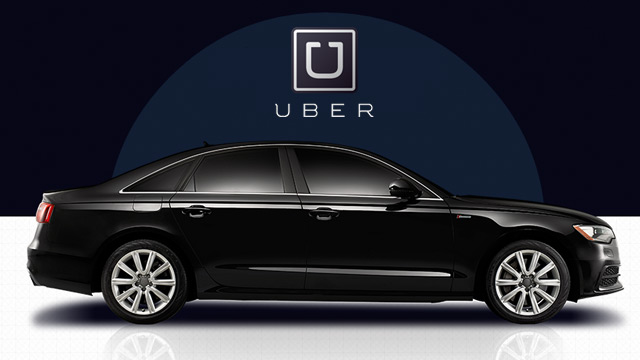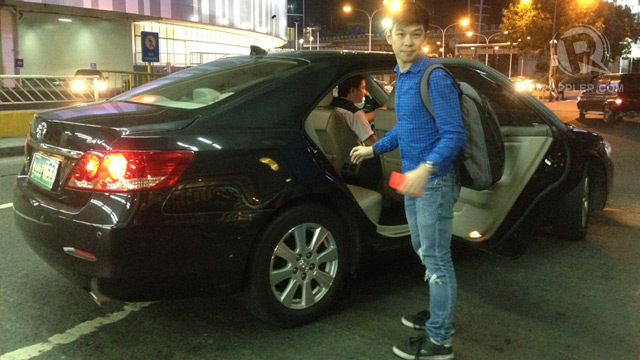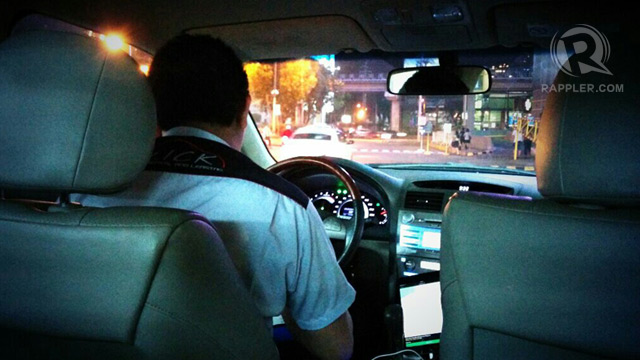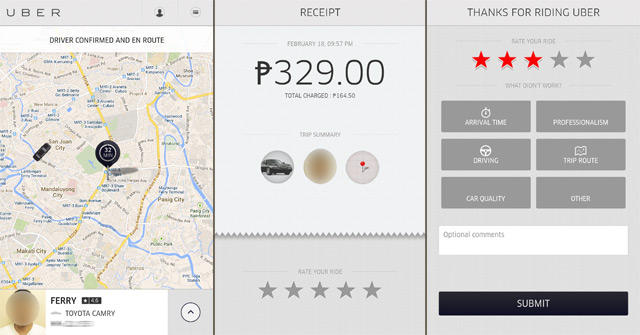SUMMARY
This is AI generated summarization, which may have errors. For context, always refer to the full article.

MANILA, Philippines – Why drive a car when you can just share “everyone’s private driver?”
Uber, a new app-based chauffeur service offers a new way of looking at commuting. The San Francisco-based startup set up shop in Metro Manila last week with a unique proposition. They get you a car and personal driver, but you only pay per use.
The idea is not only innovative but green, and with the impending “carmageddon,” timely. Private cars spend most of their lives parked, while shared cars are more utilized. The concept of a shared economy hugely impacts congestion and the environment.
Uber Regional Manager Michael Brown said these are values that are very important to the company – “to innovate in order to make transport less expensive, to reduce congestion in cities, and to make transport more environmentally sane so we don’t ruin our planet.”
The concept behind the new service is simple and familiar. You do everything on the Uber app (available on iOS and Android) – sign-up, order a car, track the car, contact the driver, and rate the experience.
But Uber shouldn’t be confused for a taxi. On its network is a mix of high-end cars, “everything from a Mercedes E Class to a Toyota Camry.” Imagine a premium car, black, without any branding and with a leather interior.
Of course luxury comes at a price. Brown says the price of an Uber is about 1.25x the cost of a taxi but that’s a conservative estimate. Expect your Uber ride to cost up to 2x of what you’d normally pay for a cab ride and about 1.3x the cost of app-based taxi booking services like GrabTaxi and Easy Taxi.
Frills aside, Brown said other key differentiators of his company are “convenience of payment and the accountability” that Uber brings to transport and safety.
Booking a car and a driver

The most tedious part of the process is signing up, a 5-minute process which entails having to key in your credit card details and verifying your email address.
The good news is you only have to do it once. Next time you launch the app you’ll immediately see a pin with your current location and the estimated wait time. Click on “set pickup location” which loads another screen where you can either get a “fare quote” and/or “enter a promo code” before you finalize your order by clicking on “request pickup here.”
Soon you’ll move on to another screen that says “driver confirmed and en route” with a real time map for tracking the car. You’ll also get the driver’s name, plate number, and contact number and options to call and message the driver himself.
 Josh: We didn’t tell Uber we were doing a test and decided not to use any of our promo codes for this particular piece. I was a bit disappointed that the wait time was 30 minutes. I had loaded the app from home and got estimated wait times between 8-10 minutes. I was told that 10 minutes is also the average wait time in Makati too.
Josh: We didn’t tell Uber we were doing a test and decided not to use any of our promo codes for this particular piece. I was a bit disappointed that the wait time was 30 minutes. I had loaded the app from home and got estimated wait times between 8-10 minutes. I was told that 10 minutes is also the average wait time in Makati too.
I did like how easy it is to use the app. I use app-based taxi booking services all the time and it’s never as straight forward as this. Soon after our booking was made, the driver was texting and calling to make sure he got the exact pick-up point. I also liked the split fare option, which allows you to invite a second passenger to share the ride and costs with. On this trip I shared a ride with my car-pool buddy and colleague Jessica who immediately after I clicked on split fare, got an invite on her iPhone.
 Jessica: It took 26 minutes for the car to arrive. Good thing we were at a mall and were not in a hurry, otherwise waiting would have been an inconvenience. The driver took the initiative to text and call to clarify where the meeting point would be, so we were assured we would get a ride and that there was no glitch in the system. What I loved most about booking an Uber ride is that specifying the dropoff location is not a requirement. This means you won’t get discriminated against by drivers who decide to take you (or not) based on where you’re headed.
Jessica: It took 26 minutes for the car to arrive. Good thing we were at a mall and were not in a hurry, otherwise waiting would have been an inconvenience. The driver took the initiative to text and call to clarify where the meeting point would be, so we were assured we would get a ride and that there was no glitch in the system. What I loved most about booking an Uber ride is that specifying the dropoff location is not a requirement. This means you won’t get discriminated against by drivers who decide to take you (or not) based on where you’re headed.
I had very few expectations from this ride because I wasn’t very familiar with the app. In fact, I only installed it because Josh wanted to try the “Share the Fare” feature. All I knew was that it wasn’t going to be the usual taxi and that we what we were waiting for was a Toyota Camry.
The ride
We travelled from SM Megamall in Ortigas to Katipunan in Quezon City on a black Toyota Camry. Our trip covered a distance of 12.59 km and took 27 minutes and 3 seconds.
 I had interviewed Michael Brown a few days before our first Uber ride so my expectations were built up. I was told the chauffeur would open the door for me and then offer me a bottle of water – none of this happened, but maybe that’s nitpicking. The ride was comfortable, leaps and bounds from a taxi. But unlike a taxi that knows the city streets well, our driver, who in a pre-Uber life shuttled banking clients to and from work, didn’t know the city like the back of his hand and relied on us for directions. And because we were too engrossed in our conversation, we , for example, the driver takes you off course. A representative will recalculate the route and give you a credit refund. I wanted to give the experience 3 of 5 stars but Jessica stopped me because the driver supposedly rated us 5 star passengers.
I had interviewed Michael Brown a few days before our first Uber ride so my expectations were built up. I was told the chauffeur would open the door for me and then offer me a bottle of water – none of this happened, but maybe that’s nitpicking. The ride was comfortable, leaps and bounds from a taxi. But unlike a taxi that knows the city streets well, our driver, who in a pre-Uber life shuttled banking clients to and from work, didn’t know the city like the back of his hand and relied on us for directions. And because we were too engrossed in our conversation, we , for example, the driver takes you off course. A representative will recalculate the route and give you a credit refund. I wanted to give the experience 3 of 5 stars but Jessica stopped me because the driver supposedly rated us 5 star passengers.
 The car arrived on time and at the exact pickup point we specified. It had really nice leather seat covers and didn’t look or smell filthy. The driver greeted us and asked if we wanted the radio on and if it was too loud, and if the air-conditioning was too cold or too warm. I was surprised to see the driver using an iPad mini to book and navigate instead of the low-end Android phones used by drivers of GrabTaxi and Easy Taxi of which I am a regular user.
The car arrived on time and at the exact pickup point we specified. It had really nice leather seat covers and didn’t look or smell filthy. The driver greeted us and asked if we wanted the radio on and if it was too loud, and if the air-conditioning was too cold or too warm. I was surprised to see the driver using an iPad mini to book and navigate instead of the low-end Android phones used by drivers of GrabTaxi and Easy Taxi of which I am a regular user.
What can be disappointing for some customers is the driver’s lack of route knowledge. This is acceptable or may even be better if you’re headed in a familiar destination and prefer to direct the driver to take your preferred route. However, if you’re going somewhere for the first time you’ll both end up lost.
Post-ride thoughts

 I got off at the corner street by my house, not wanting to make it difficult for the driver to have to drive in 10 meters just to make a u-turn to get back on course. The driver hesitated, he wanted to get me home safe. Props to him for that (okay maybe he doesn’t deserve just 3 stars).
I got off at the corner street by my house, not wanting to make it difficult for the driver to have to drive in 10 meters just to make a u-turn to get back on course. The driver hesitated, he wanted to get me home safe. Props to him for that (okay maybe he doesn’t deserve just 3 stars).
Because I wasn’t the final stop I didn’t know how much the total fare was. But as soon as Jessica was dropped off we both got emails informing us that our credit cards were deducted half of the actual fare. From SM Megamall to Katipunan via EDSA, Kamias and Xavierville, our total fare cost just under P330. The same route on a regular taxi costs us P180 on average. We could have saved an extra P20 had we not decided to split the fare. If you plan on regularly using Uber to carpool (which you can up to 4 people), we recommend you don’t use the app’s sharing feature and work out the costs internally. Each passenger added to the split fare list is charged P10.
After the ride is over you are asked to rate your driver. If you give him 3 stars and below you’ll be asked what didn’t work, with the option to pick arrival time, driving, car quality, professionalism, and trip route as factors.
 The trip cost above P300, which is about twice what we pay for cab rides and only a few pesos more expensive than GrabTaxi and EasyTaxi. Another unique Uber feature that I like is the two-way feedback system – something I find lacking in taxi booking apps – for which the driver gave us 5 stars. Lastly, and this is what will probably make me want to book an Uber ride again, the driver offered to open the door for me before I got out of the car – something that you don’t get a lot as a commuter. There’s nothing like the feeling of safety when you go home every night at an ungodly hour.
The trip cost above P300, which is about twice what we pay for cab rides and only a few pesos more expensive than GrabTaxi and EasyTaxi. Another unique Uber feature that I like is the two-way feedback system – something I find lacking in taxi booking apps – for which the driver gave us 5 stars. Lastly, and this is what will probably make me want to book an Uber ride again, the driver offered to open the door for me before I got out of the car – something that you don’t get a lot as a commuter. There’s nothing like the feeling of safety when you go home every night at an ungodly hour.

Despite their company motto, Uber isn’t for everyone, at least for now. The biggest barrier to universality is the credit card requirement. Brown said the company is looking into other forms of payment. “Ultimately we want people to ride and are looking into other payment gateways to make Uber universally accessible,” he said.
A company that prides itself in its ability to innovate, Uber is also looking into solving the “last 100-meter problem” with even better mapping solutions to help connect drivers with riders.
While our 30 minute wait, and not so route-savvy driver signal that the company is still going through birthing pains, the idea is one worth looking into.
The service is perfect if you don’t have a car and/or driver and want to travel in style to a party, business meeting or some other important event, or if you just feel like you deserve a travel upgrade but don’t want to spend on a car just yet. – Rappler.com
Add a comment
How does this make you feel?
There are no comments yet. Add your comment to start the conversation.